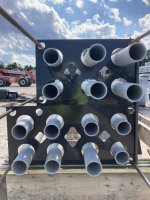Thank you Tusla for the question. First of all I was Mr. Julius Right when I was boss, but now I am retired and you can only address me as, simply, Julius.
The Royal Society's motto 'Nullius in verba' is taken to mean 'take nobody's word for it'. It is an expression of the determination of Fellows to withstand the domination of authority and to verify all statements by an appeal to facts determined by experiment.
So, my calculation based on an old Visual Basic program-I did it myself 20 years ago-it is not a modern one based on ETAP or else. The advantage is that I can modify it as I like it.
Now, as an answer to your question. Actually, in our design, we used schedule 80 pvc duct for concrete duct bank and not art.352 schedule 40 as I indicated above. The available cross section it is less but still enough.
If we refer to the MCC actual load I think we always take the MCC rated as cable possible load. I think I can consider only 3 busy ducts instead of 4-since the 4thd is reserve.
Another possibility is to check the voltage drop. Let say 3% at 200 feet length 3 parallel cables at 3*480 V rated the voltage drop is 14.4 V then 14.4/1.73/0.04/0.2[see chpt.9 Tab.9 NEC]=1039 A and 346 A per cable.
I have to try other possibilities: increase the distance between ducts may I can get 200 A ,for instance.
The demand factor of 0.6 [60%] may be also.

